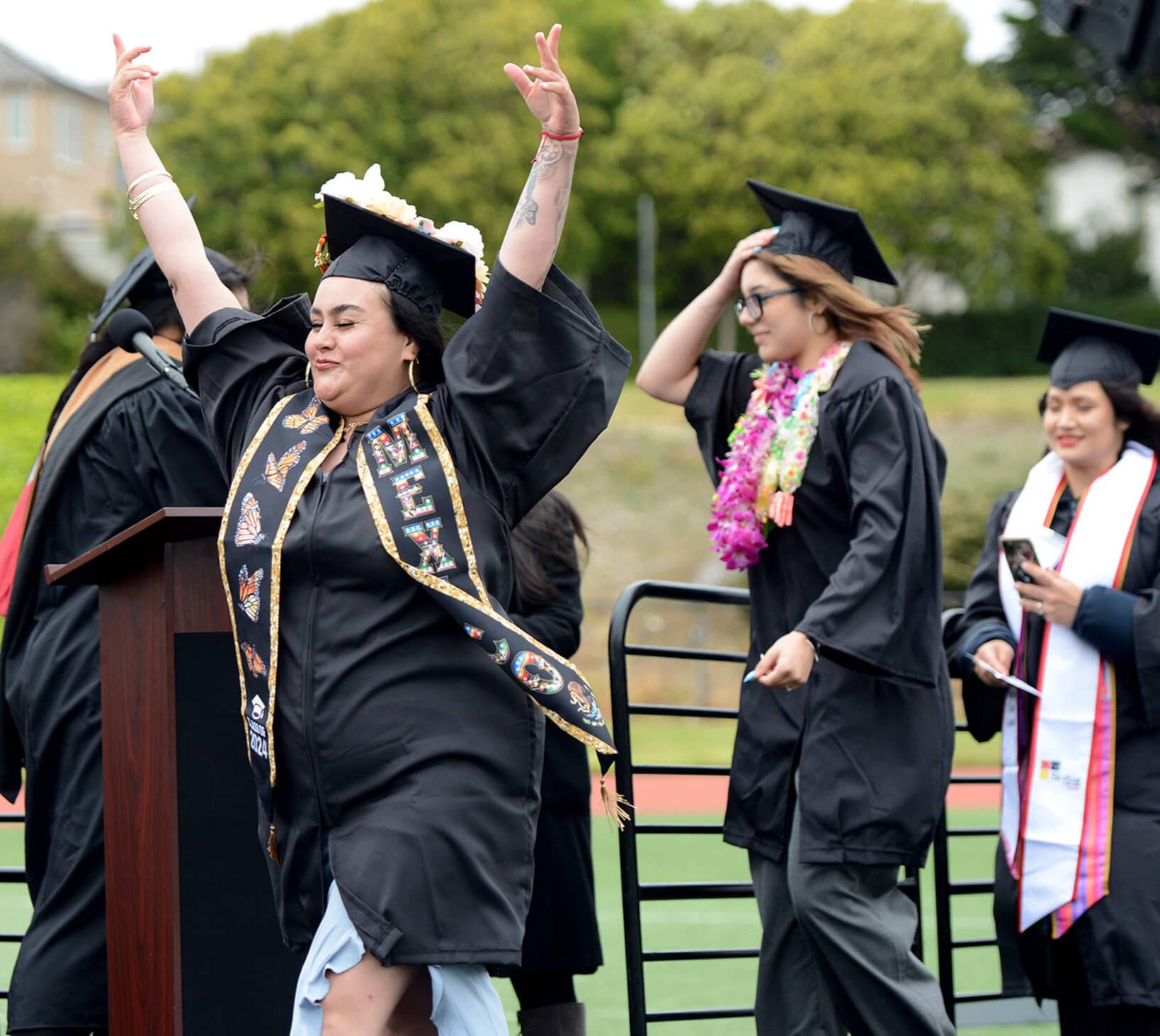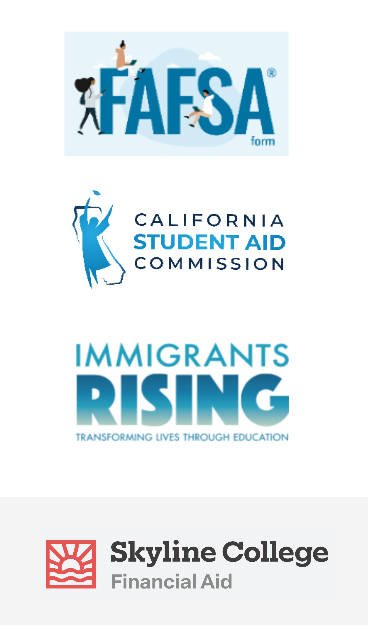Financial Aid Facts for Everyone
Before You Begin
You are your own best teacher.
When it comes to financial aid, the answer is often “it depends.” That’s why Skyline College’s Financial Aid Office is here—to guide you and help you maximize the aid available to you.
We encourage you to read, reflect, ask questions, and talk with friends or others as you navigate your path toward financial well-being.
If anything feels unclear or too good to be true, don’t hesitate to reach out. Connect with us to learn how Financial Aid can support your goals.

Did You Know Millions in Aid Go Unclaimed Each Year?
Every year, thousands of students and families miss out on free money like Pell Grants, Cal Grants, and scholarships simply because they:
-
Don’t know what’s available
-
Assume they won’t qualify
-
Get stuck or overwhelmed during the process
-
Think they completed their application but don't get in contact to understand what they are eligible for
-
Didn't understand why it's worth applying to financial in order to try to get into support programs such as Promise, EOPS, TRiO, Sparkpoint and other internship, research, appreticeships, or scholarship opportunities.
- Have a simple issue to resolve with their name, date of birth, social security, or program of study
Don't let that be you! More people qualify for aid than you might think, and many forms of aid are guaranteed for eligible applicants.
Students at Skyline Receive $10,000+ in Aid
Some of our students receive over $10,000 in grants and scholarships: free money that never has to be repaid.
Financial aid can help cover:
Textbooks
Transportation
Technology
Housing, food,
even childcare
And any cost of attendance—for now or future terms
The Application Takes ~30 Minutes
FAFSA: Free Application for Federal Student Aid
- Provides federal, state, and institutional aid
- For U.S. Citizens and Permanent Legal Residents (Green Card Holders, Refugee, Asylee etc.)
- Check if you have FAFSA eligibility
CADAA: California Dream Act Application
- For state and institutional aid
- Students who are undocumented, DACA recipients (valid or expired), have a U Visa, or Temporary Protected Status (TPS)
- Check if you have CADAA eligibility
CCPG: California College Promise Grant
- A tuition waiver for for eligible California residents
- CCPG covers tuition fees, but does not cover non-tuition fees like student life fees and textbook costs.
- Check if you have CCPG eligibility
Free College for San Mateo County
- 2 levels of support to reduce or eliminate tuition & fees
- For San Mateo County residents, including undocumented students
- You must intend to earn a certificate or degree
- Learn Moreabout Free College
Apply Early, Accurately, and Fully
Submitting your application correctly avoids delays and helps you get the support you qualify for. These tips will help you:
-
Complete the correct form each year, accurately.
-
Use your government-issued name to avoid delays.
-
Submitting the application doesn’t guarantee aid.
-
Additional steps (e.g., documents or verification) may be required before aid is awarded.
If you’re unsure of your status:
- Log in to your account for FAFSA or CADAA and check your application status
- Review any emails from FAFSA/CADAA or your college
- Connect with the Financial Aid Office to confirm that you’re all set

Need Help Applying?
Check out these trusted resources for step-by-step guides, FAQs, and workshops:

Let's Get Started
Learn how financial aid works, how to apply, and how to avoid common pitfalls so you can make the most of your college experience.
Why You Should Apply
Financial aid isn’t just for low-income students.
You may qualify for grants, scholarships, and support programs like Promise, EOPS, or TRiO regardless of your family’s income.
While some aid is based on income, family situation, and financial “need,” there are many forms of aid that aren’t—and you won’t know what you qualify for unless you apply!
It’s your money—claim it.
When you apply for financial aid, you can reclaim taxes that you and your family have
already paid through grants, scholarships, or program subsidies. Get that support
and make the most of your college experience.
Grant = Free money
Programs like the Pell Grant, Cal Grant, and Student Success Completion Grant offer
funds that you don’t repay. These programs exist because families like yours have
already contributed through taxes, so you should apply.
FA covers more than just tuition.
Financial aid can help with:
- Books & supplies
- Housing
- Food
- Transportation
- Childcare
- or any cost of attendance
Unused aid may even be saved for future semesters. Applying can also help you gain access to learning communities that offer even more support.
You don’t need to be a full-time student.
Part-time students are still eligible for aid! See which application is right for you.
FA opens doors to more opportunities.
Financial aid may be the first step toward qualifying for various programs that require
a FAFSA or CADAA on file:
- Internships & fellowships
- Scholarships
- Research programs
Less stress = more success.
Financial aid exists to reduce the financial burden of college so you can focus on
what matters: learning, growing, and reaching your goals in school and beyond.
Common Myths & The Truth
“I’m not eligible.” or “I don’t know what to apply for.”
Don’t assume you're ineligible. Most students qualify for at least one of the following:
- FAFSA (Free Application for Federal Student Aid)
- CADAA (California Dream Act Application)
- CCPG (California College Promise Grant)
- Free College for San Mateo County residents
“My grades aren’t good enough.”
False! Financial aid is not just for straight-A students. Many aid programs are based on
need or other factors—not GPA. Even if your grades aren’t perfect, you can still qualify
for grants and scholarships. And if you’ve faced academic challenges, there’s often
an appeal process you can explore. Learn about Satisfactory Academic Progress.
“My parents make too much money.”
Not necessarily! Some grants and scholarships aren’t based on income. Completing the FAFSA or CADAA
is the only way to know what you're eligible for. You may be surprised by the results.
“I have savings and a job, so I don’t need financial aid.”
Why not? Even if you’re working or have savings, aid can cover costs like textbooks, supplies,
transportation, or childcare and let you save your income for something else. Check
out Free College: Level 2.
“Community college is free, so I don’t need to apply.”
Not necessarily! Some students do qualify for free tuition, but applying for financial aid can still
help cover non-tuition expenses, like food, housing, books, and more.
“My parents didn’t file taxes, so I can’t apply.”
False! You can still complete the FAFSA or CADAA using alternative documentation.
“I live on my own and support myself, so I’m an independent student.”
Maybe. Living independently doesn’t make you “independent” for financial aid purposes. FAFSA
has specific criteria for determining dependency. If you indicate Yes to "Personal, Other" “Unusual Circumstances,” you’ll need to
provide documentation and work with the financial aid office to complete your application.
“If I’m Pell Grant–eligible, I need at least 6 units.”
Not true! Pell Grant funding is based on enrollment intensity— you can receive aid even with less than 6 units, and you'll get more if you take
more units.
However, students enrolled in fewer than 6 units may miss out on:
- SEOG (Supplemental Educational Opportunity Grant)
- Federal Work-Study
- Student Success Completion Grants
- Federal loans
Talk to your technician about your unit load and how it impacts your total aid package.
Self-Advocacy & Supporting Your Peers
It’s okay to feel nervous about following up—whether you missed an appointment, are waiting on a reply, or don’t want to “bother” anyone. But always make sure to follow up and advocate for yourself!
Many students feel unsure or overwhelmed by the financial aid process, but you can help change that. If you learn something helpful, share it. Point a friend to information, encourage them to apply, or go through the process together.
Being informed empowers your whole community. When students support each other, everyone wins!
Key Application Facts
One application = multiple opportunities.
By completing the FAFSA or CADAA, you’re automatically considered for multiple forms
of aid.
You must apply every academic year.
Financial aid doesn’t roll over. You need to reapply annually—each application covers
the academic year from July to July.
Best time to apply
Start in November and complete before the March priority deadline. Even if you miss
the priority deadline, you should still apply!
Deadlines are critical.
Track important dates on your calendar—planning ahead is a key part of success!
- Priority & non-priority deadlines (FAFSA, CADAA, CCPG)
- Census dates
- Disbursement dates
- Add/drop deadlines (for refunds or avoiding a “W”)
- Pass/No Pass grade request deadline
- Last day to appeal
Disbursement ≠ instant cash.
Your aid is sent to you via BankMobile or your school’s refund system. Make sure your refund account is set up in advance to avoid delays.
Confirm your Program of Study.
To receive federal aid, you must be enrolled in an eligible certificate or associate
degree program that aligns with your educational goal. Check with your counselor or
the financial aid office if you’re unsure about this.
Use your full legal name.
When creating your FAFSA or CADAA account, make sure you and all of your contributors
use the exact name shown on your Social Security cards if you have them.
What if a contributor doesn’t have a Social Security Number (SSN)?
That’s okay! They can still create an account using a process for contributors without an SSN. The system will guide them step-by-step.
Graduated high school in another country?
- In the “High School” section, type “FC” in the City field and press Search
- Click “Add Manually”
- Enter “FC” again in State
- Then check the box and write the actual City and High School name
Maximizing Your Aid
Your aid can be adjusted!
If you or your parents’ income has significantly changed since 2023 (for the 2025–26
aid year), or you're facing special or difficult circumstances, you may be able to
appeal to increase your aid. Ask the Financial Aid Office how to get started.
You may qualify for multiple grants.
Many students receive the Pell Grant and the Cal Grant, plus additional support depending
on eligibility and enrollment.
Federal Work-Study = Paid job on campus.
This program helps you earn money through part-time work while staying connected to
your school and building valuable work experience. Ask if you qualify!
Staying Eligible: Academic Progress Matters
To keep receiving financial aid, you must meet Satisfactory Academic Progress (SAP) standards:
- Maintain a 2.0 GPA
- Successfully complete at least 67% of the units you attempt
Withdrawals and failed classes can affect your SAP status.
Got Questions? Get Answers.
We're here to help—and it's always better to ask early than to miss out later.
Contact Financial AidTranslate This Page